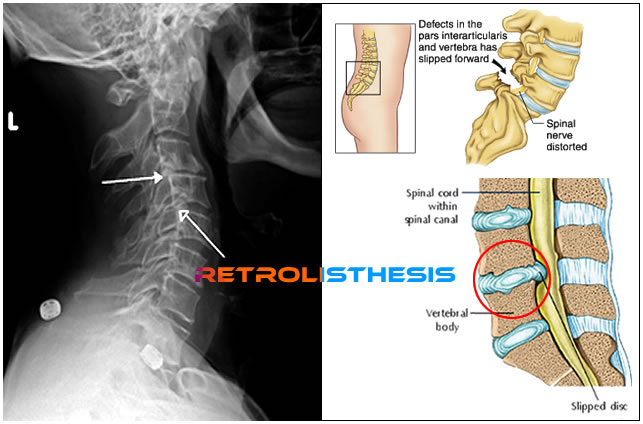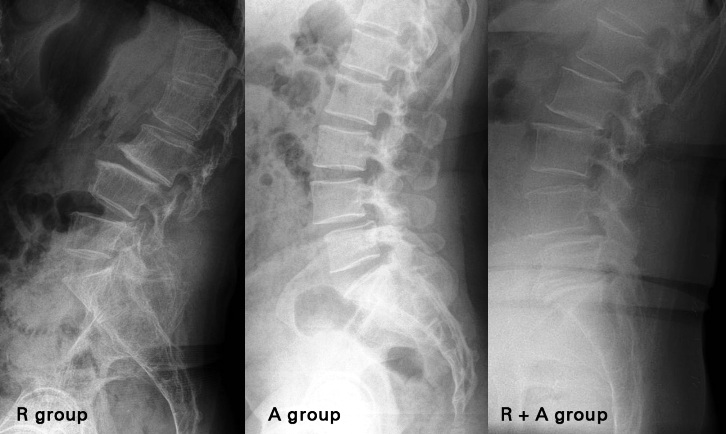Learn all about Retrolisthesis, the back pain which is due to the displacement of vertebrae of the spine, its symptoms, causes and treatments used to get rid of it. Retrolisthesis is relatively rare but when present is associated with increased back pain. It has historically been regarded as an incidental finding which doesn’t cause any symptoms and is considered of no clinical significance.
Retrolisthesis is associated with back pain and impaired back function. According to literature studies Retrolisthesis has been found to be accompanied by disc degeneration, a decrease in lumbar lordosis, decrease in vertebral endplate angle and segmental height.
In children, the most common cause of Retrolisthesis is a birth defect which occurs between fifth vertebrae of the sacrum. In adults, it occurs between 4th and 5th vertebrae due to arthritis or any other degenerative disease.
It is caused by stress, fractures, and traumatic fractures. Other causes are infections of blood or bone, bone diseases, nutritional deficiencies of the components which are responsible for the building of strength and repair of discs and ligaments. It is also caused by injury and results in the instability of connecting soft tissues, muscles, tendons, and fascia.
As it is a degenerative, acute and congenital condition. The degenerative spinal changes are seen at levels. These changes are evidenced by end plate osteophytosis, disc damage, disc narrowing, tearing failure and result in disc bulging. It is worsened with time, gradually becoming irreversible.
Although it is treated by non-surgical treatments by repositioning, Robb myofascial release water therapy and microcurrent therapy. Also, some physical treatments such as mobility, flexibility, and strengthening exercises are suggested which include hip rolls, lower back rolls, and pelvic tilts.
Retrolisthesis-Definition, Causes, Symptoms, Treatment
Retrolisthesis is a medical condition in which vertebrae in the spine are displaced from their original position. Vertebrae move forward in many cases and backward movement is less common but occurs with considerable frequency in people with degenerative disorders. It occurs in the soft disc that separates and cushions the vertebrae. It is of three types:
- Complete
- Stair-stepped
- Partial
Retrolisthesis is caused by arthritis which leads to the rupture of disc tissues. Retrolisthesis is symptomized by severe back pain as it is graded from grade 1 to grade 4 and symptoms vary from person to person according to the type of Retrolisthesis. Treatments involve physical therapy, medication, and surgery.
Retrolisthesis Definition
Retrolisthesis is a term used to define an acute spine condition in which the backward slippage of one vertebra onto the other vertebra immediately below it takes place. Vertebrae are the bones that make up the spinal column and are separated from each other by cushioning intervertebral discs. Hence, Retrolisthesis is a posterior displacement of the vertebral body with respect to the adjacent vertebrae to a degree less than a luxation or dislocation. Retrolisthesis is seen in the cervical spine and lumbar region and also in the thoracic region.
What is Retrolisthesis?
Retrolisthesis is a degenerative or congenital condition in which the vertebra of spine gets displaced and moves backward onto the vertebra lying below it. Retrolisthesis acts as a compensatory mechanism for moving the gravity axis posteriorly for the sagittal imbalance in lumbar spine under low pelvic incidence and insufficient intra-spinal compensation .In most cases of vertebral slippage, it will involve a forward movement of an upper vertebra which will slip towards the chest.
Grade 1 Retrolisthesis
Grade 1 Retrolisthesis is the most minor occurring state in which the vertebra are slightly misaligned up to 25%. We can say that the posterior displacement of up to ¼ of the intravertebral foramina (IVF) is graded as Grade 1 Retrolisthesis. The intravertebral foramina contents include spinal nerves (sensory and motor neurons), nerves, arteries, veins and lymphatic vessels which cater to the nutritional and waste removal needs of the spinal cord. Degenerative spinal changes are often seen at levels where a Retrolisthesis is found.
Retrolisthesis Symptoms
Symptoms of Retrolisthesis vary from person to person. Some symptoms include;
- Stiffness
- Chronic back pain
- Numbness
- Dull neck pain
- Tenderness in neck area if it is cervical Retrolisthesis.
Lower spinal area Retrolisthesis shows the symptoms such as;
- Mobility that can be significantly limited
- Constant pain when walking, sitting or standing
- Tingling sensation in torso , legs and arms
- Structural instability
Retrolisthesis Causes
Retrolisthesis may occur due to the underlying causes;
- Mechanical damage from physical trauma such as: accidents, falls and repetitive use of poor posture etc.
- Nutritional deficiencies of components that make possible the building of strength and repair of discs and ligaments.
- It may also be caused due to arthritis in older people, which may lead to deterioration of disc tissue.
- It can also be caused due to congenital spine defects and severe back injuries.
Retrolisthesis Treatment
Retrolisthesis treatment depends on its grading or its strategies are aimed at controlling and reducing pain. The treatment includes the intake of nutritious food because it aids in the repair of the soft tissue of spine. Nutritious food includes some nutrients such as;
- Zinc: shrimps and oysters are the rich source of zinc. It includes vitamin A which aids in repair of tissues. It can be obtained from orange, butter and cod liver oil.
- Copper: It provides strength to ligaments
- Vitamin C: Acts as an antioxidant.
- Manganese: Aids in cross linking proteins.
- Water is also essential because it aids in the height of intervertebral disc.
For retrolisthesis treatment Glucosamine 1500mg/day may be prescribed. Physicians advise maintaining the healthy weight. Reposition of displaced vertebra is also useful. Sometimes surgery and microcurrent therapies are also used. Taking some precautions such as sitting in a proper way and having regular exercise can prevent Retrolisthesis.
 Health & Care Information
Health & Care Information 



